
In the early 1800s, morphine and opium were the drugs of choice for treating tuberculosis (and many other diseases). Drugs that actually cured the disease, or even its symptoms didn’t exist yet, so all that physicians could do was dose their patients with something to dull their pain. Morphine, along with its derivatives, including opium, laudanum (used to induce sleep), and heroin (good for quieting a cough), were perfect for this. Unfortunately, many doctors neglected to mention its addictive qualities, and patients were addicted before they knew it.
With the antibiotic resistance that many strains of tuberculosis are now showing, how soon before we're back to morphine with no other alternative?
For more about morphine and its role in Victorian treatment, click here or here.
1 comment:
It's amazing how often the same narcotics crop up in historical cures for diseases. Of course none of them were actually cures but some did help alleviate some symptoms and some of them just made you care less about the symptoms. As a child (and I'm not that old, this would be the 1970's) I would take Kaolin and Morphine for stomach problems and I think you can still get it in England at least, not as a prescription just from any pharmacist. Kaolin is basically chalk and the morphine is in a low dose but is quite effective at relaxing the muscles of the intestine. I think Laudanum must have had similar effects. I don't remember it having narcotic properties. In a very Proustian moment I am instantaneously reminded of the strong chalky taste.....
Post a Comment